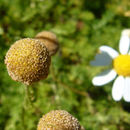Biology
(
İngilizce
)
Arkive tarafından sağlandı
The flowers of this perennial plant appear from June to August (2), and have been widely used for many years for a variety of purposes; they are known to have certain medicinal properties and are used as an antispasmodic and an anti-inflammatory, and the essential oil is used in aromatherapy as a soothing agent (5). Chamomile flowers have also been used to make herbal teas and beers, and are known to repel insects when both living and dried (5). Chamomile lawns have been popular in the past, and 'chamomile seats' were a common feature of Elizabethan herb gardens (3).
Conservation
(
İngilizce
)
Arkive tarafından sağlandı
Chamomile is included in Plantlife's 'Back from the Brink' programme.
Description
(
İngilizce
)
Arkive tarafından sağlandı
Chamomile (Chamaemelum nobile) is a low-growing plant with finely divided leaves, which are arranged alternately on the stem (2). The daisy-like flowers have a yellow central disk framed with silvery-white petals (2). When crushed, the plant gives off a scent akin to that of apples or bubblegum (3), and this trait led to the origin of the common name; 'chamaimelon' means 'ground apple' (4).
Habitat
(
İngilizce
)
Arkive tarafından sağlandı
The main natural habitats of this species are grazed grasslands on cliff-tops, heaths, commons and village greens with moderately acid clay soils (6). At present it thrives in a number of cricket pitches, where mowing and rolling create ideal short turf conditions (3).
Range
(
İngilizce
)
Arkive tarafından sağlandı
This plant was once found throughout most of England, but has always been more common towards the south (3). It is now unfortunately scarce in the UK, and is most common in the extreme south-west and Hampshire (3), with remaining strongholds in the Lizard Point Cornwall, Dartmoor and the New Forest (3). Elsewhere the species occurs naturally in Western Europe, North Africa and the Azores and as a garden escapee in North America (2).
Status
(
İngilizce
)
Arkive tarafından sağlandı
Classified as Nationally Scarce in Great Britain (1).
Threats
(
İngilizce
)
Arkive tarafından sağlandı
The main cause of the drastic decline of this once widespread species has been the cessation of grazing in many areas, particularly on village commons (3).

